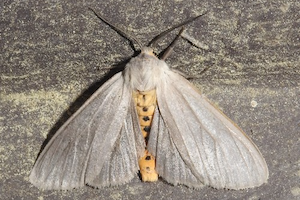Photo Credit: © joannerusso via iNaturalist.org. Creative Commons Attribution-NonCommercial 4.0 International (CC BY-NC 4.0) License; https://creativecommons.org/licenses/by-nc/4.0/.
Euchaetes egle
Common Name: milkweed tussock moth
Other Common Names: bolsero calandria
Animal Guild: Insect
Class > Order > Family: Insecta > Lepidoptera > Erebidae
